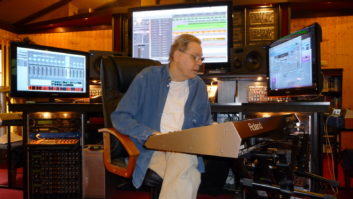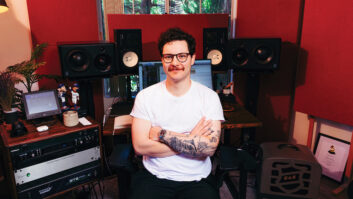With a vast catalog of albums already in hand and having achieved the commercial success that most bands can only dream of, Styx could have called it a day decades ago with classic albums like The Grand Illusion and Pieces of Eight, indelibly fused into our collective prog-rock radio psyche.
But if there is one thing Styx is known for, perhaps it is the amazing work ethic that has carried the band well into its fourth decade. With the release of The Mission, recorded in the midst of a seemingly never-ending touring schedule, Styx returns to the studio to deliver captivating performances inside a thematic capsule that every human can relate to. Pro Sound News spoke to guitarist/vocalist Tommy Shaw about suiting up for the ultimate listening journey.
ON DISTANT JOURNEYS:
All of a sudden these songs started coming, which is always the best way to write. It is like transcribing this thing that is almost fully formed. In this case, it all started out as the ‘Mission to Mars’ song. The lyric was about these years of talking about the mission, planning for it, and then finally the day itself when it takes place: the day when these people were going to strap themselves to a rocket, light the fuse and blast off into space, leaving everyone and everything behind and maybe never returning. This is the story, and it is a story about the human experience. This is something that Styx has always been pretty good at.
ON CREW ASSEMBLY:
We [Shaw and collaborator Will Evankovich] had been developing the idea over the period of a couple of years, but hadn’t mentioned it to anybody because we knew it would take a while before it could be produced—and that would not have helped the creative process. Over the course of all our touring, we had to find breaks to get it done, and that is why it was such a big ‘secret’. The demos we created were really good and didn’t leave anything to the imagination, so there came a point where we said, ‘Let’s tell the guys about our idea.’ They were all intrigued—so the big question was how we would we do this in the midst of all of our touring. But we now had a blueprint for the record and the next step was to get it all down on tape.
ON MAGNETIC PARTICLES:
We decided early on to have the whole thing sound like it could fit in with other classic Styx records—not modern at all. It was so much easier this way. Our vocals were going to sound like us because it is us. We used the same instrumentation as on our earlier records and kept it simple—something that could be recorded on analog tape. The drums were recorded onto (2) 24-track Studer machines through the Neve console at Blackbird Studio. Across the entire record, there was not a single digital plug-in, and any kind of delays or echos were the product of a 1/4” tape or 1/2” tape machine. Jim Scott [mixer], who was also a huge proponent of the analog sound, had a great formula where he could figure out the delay times, which he did by hand. You add all these little things together on tape and you get this beautiful sound over the top of it—nothing else sounds like that.
ON SIX-STRING SOJOURNS:
The guitar parts themselves really dictate who plays them. I wound up doing a lot of the meat and potato parts—rhythm guitars and what not. James Young ended up doing what he does best, and that is playing lead parts on a lot of things even if they are not solos. For example, on ‘Outpost’, that is James Young playing, and the intro of ‘Gone Gone Gone’ started as something that he was noodling with, doing his Jeff Beck impersonation for his own entertainment. I am usually playing the more compositional guitar solos. In the writing part of this record, I had a Kemper amp nearby—it is so easy because you don’t have set up a cabinet with mics or anything. But when it came down to it, I used a Bogner Shiva amp that I got off of Craigslist. This had that Marshall sound I was looking for, but also the same kinds of clean sounds we used while making The Grand Illusion and Pieces of Eight.
ON COMING HOME:
When we finally finished it, we had a few ‘friends and family’ listening sessions at Blackbird and played the production demos. It was the first time we got to hear the whole record as a complete piece in the sequence it was meant to be in. We had this big room full of people there and printed out the story for them. When it was finished, people were stunned and were saying all the things we’d hoped they would say. It kind of freaked me out because the album turned out to be exactly what we wanted it to be.
ON A ‘MISSION FROM GOD’:
The Grand Illusion album came from when we were starting to have a little bit of success—we tasted a little bit of rock stardom and noticed how it was affecting us. I remember being at Paragon Studios in Chicago when we finished; we all knew it was something special. I remember telling everyone to be careful crossing the street, because this album was going to change our lives. The song had a bullet on the Billboard Chart and ended up dying at number 28, so my friend Jim Cahill and I went out and hit it again and again. We talked about it all the time—we were like the Blues Brothers ‘on a mission from God’ and we were not going to let this stand. It was ‘Come Sail Away’ for God sakes! So we did what was necessary to get the song’s bullet back, and the rest is history.
Jacques Sonyieux is a devout explorer of recording studios and the artists that occasionally inhabit them. Please send any tips or feedback to Jacques at: [email protected].







